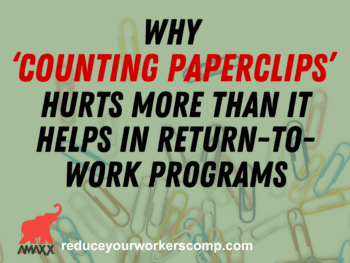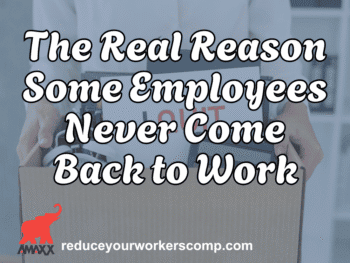
Common Stumbling Blocks to Effective Return to Work
Return to work should be considered and driven immediately after any work injury and the employee is stabilized. Delays in taking steps toward a return to work will promote malingering and allow the employee to become deconditioned. The result is ongoing medical care will be prolonged, and more money will be spent during the life of the claim. Now is the time to review your workers’ compensation program to identify and remediate any barriers that plague success.
- Prompt Claim Reporting: All interested stakeholders need to be laser-focused when it comes to the reporting of a work injury. This includes providing resources for anyone to report an injury and using technology to ensure the accuracy of the information reported. All stakeholders should also emphasize the steps to report a work injury at new employee orientation and safety training.
- Coordination with Treating Doctor: Employer representatives and the claim team can be responsible. Employers can take proactive steps, such as establishing a Preferred Provider Organization (PPO) to provide non-emergency medical care. Claim handlers should also contact employer representatives to ensure updated restrictions are received, and a treatment plan is clearly defined. Knowing current restrictions is critical to getting an employee back to work.
- Establishing a Culture of Trust: This can be accomplished by remembering all employees are humans and treating them with respect and dignity. This includes dealing with work injuries involving malingering and potential fraud. Respect gets noticed and improves workplace morale.
Many steps can be taken to drive an effective return to work. Other suggestions include frequent follow-ups with the injured employee that include employer representatives.
Thinking Outside the Box: Nutrition and Health
Diet and exercise are crucial drivers to helping an employee get back to work following a workplace accident. These items are often forgotten as they are not “required” benefits. Adding these elements allows interested stakeholders to drive better results and reduce program costs.
- Smoking Cessation Programs: Employees recovering from fractures or surgery incidents can depend on nicotine delivered via smokeless tobacco or cigarettes. The scientific data has long since conducted these chemicals decrease recovery, leading to less than optimal results. Offering smoking cessation programs can promote a quicker recovery from any work injury.
- Diet and Nutrition: Another element often missing from return to work programs is assistance with diet and nutrition. Assisting an injured employee sub reviewing what they eat can reduce problems with constipation or bowel irregularity commonly found in people using opioid-based medications. Adding roughage to the diet can resolve these issues without requiring additional and costly prescription medications.
- Sleep Study Programs: Any work injury significantly impacts any employee’s regular schedule. When they are off work, they tend to go to bed late and sleep later in the morning. Workers’ compensation programs that offer an employee off work with sleep studies have allowed employees to get better and more restful sleep and assist the participants in maintaining a regular sleep schedule. The result is a decrease in deconditioning.
Some of these steps can include making a registered dietician or nutritionist assist an injured employee with recommendations on their diet and exercise. Other ideas can include providing a complimentary gym membership with incentives for the employee suffering from a work injury. It is also crucial to consider mental health and the barriers presented to the employee after a work injury. Creative thinking is required to overcome these challenges and assist the employee in getting back to work.
Conclusions
There are many challenges an injured employee faces following a work injury that can be overcome with a timely return to work program. This should start at the time of injury and help facilitate a timely and accurate reporting of the work injury. Other factors should consider employees’ challenges and address diet, nutrition, and mental health. When these matters are addressed, the employee will accomplish a quick return that will reduce program costs.

Contact: mstack@reduceyourworkerscomp.com.
Workers’ Comp Roundup Blog: http://blog.reduceyourworkerscomp.com/
©2023 Amaxx LLC. All rights reserved under International Copyright Law.
Do not use this information without independent verification. All state laws vary. You should consult with your insurance broker, attorney, or qualified professional.

















